Homeless students need special consideration in the classroom. Schools provide stability in the life of homeless students. The teacher’s main role is to give a safe environment. Also, they are to be supportive in trauma cases; and, to support highly mobile students. The McKinney-Vento Act is the process educators are to follow.
Unfortunately, the number of homeless students is increasing in the U.S. Also, they tend to be within low-income areas.
Homeless Characteristics
There are several commonalities of homeless students.
- First, students usually have several schools listed on their records. Also, there are gaps in academics and attendance that are poor.
- Students wear the same clothes a couple of days in a row.
- What’s more, there is poor health and hygiene.
- Also, students appear tired.
- Students are shy or they withdraw from others.
- There is a lack of participation in class or extra activities.
- They show difficulty in academic achievement.
- On top of that, there is a lack of support from family.
Strategies for the Classroom
As a student is confirmed to be without a place to live, classroom strategies are important. It’s important to complete an educational assessment.
A welcoming climate is necessary with the component of trust. Check with the student every week to assess unmet needs. Also, encourage academics, talents, and accomplishments. It is good to pair the student with a partner or buddy. In addition, give the student a job to encourage extracurricular activities. Students need personal relationships. Also, students need time to complete assignments in school. It is difficult for them to focus on learning. They are often disengaged.
Students that are homeless usually have developmental delays and learning difficulties. These are harmful and slow their ability to further their skills for learning. Much is needed to provide aid for the students. However, some programs are available to help.




